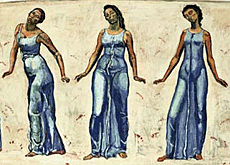Anniversary recalls Hodler’s tumultuous life

Ferdinand Hodler, who was born in Bern 150 years ago, survived poverty and scandal to become one of Switzerland's greatest painters.
Today his paintings fetch millions of francs at auction and are sought after by collectors around the world.
In November, a Hodler painting – “View of Lake Geneva with Mont Blanc in the Distance” – broke records when it was sold for SFr3 million ($2 million) at an auction in Zurich.
Born the son of a carpenter on March 14, 1853, Hodler grew up in a poor quarter of the Swiss capital, Bern.
He took up painting at an early age, selling his first landscapes – of the countryside around Thun – to tourists.
Eager to develop as an artist, Hodler fled the Bernese Oberland and installed himself in Geneva, which in his eyes was “the only cultural centre in Switzerland”. He ended up staying there for the rest of his life.
The young Hodler’s talent was spotted by Barthélemy Menn, a friend of the French painter Corot, who invited him to attend classes at the Academy of Fine Arts.
Fall
But after winning a number of prizes, Hodler then sunk virtually without trace, ravaged by deep personal crises.
For the next 20 years he lived in abject poverty in Geneva, surviving by exchanging paintings for food.
He painted the poor in a style that was a cross between realism and expressionism. His paintings were unknown to the public, and ignored or ridiculed by critics.
Hodler had to wait until the scandal surrounding his painting, “La Nuit” (Night), in 1891, to gain a reputation, albeit notorious.
Infamous
Influenced by the idealist and “art nouveau” movements, the painting shows several sleeping nudes, one of whom has woken terror-stricken and is attempting to ward off a threatening, shadowy figure clad in a black cape.
“Many is the person who has gone to bed peacefully in the evening and who won’t wake up in the morning,” wrote Hodler at the time.
The city’s authorities slammed the picture as “an attack on public morality” and banned it from Geneva salon.
However, the scandal aroused the public’s curiosity and they flooded in droves to see the painting, paying SFr1 for the privilege.
Crowds also gathered to see it in Paris a few weeks later when “La Nuit” went on show at the “Salon du Champ-de-Mars”.
Scandal
But it wasn’t until a second scandal, which provoked the longest and most intense debate on art ever seen in Switzerland, that Hodler’s international reputation was cemented.
The “Marignano” frescos, which decorate the walls of the Swiss National Museum in Zurich, were only completed two years after Hodler was handed the task.
It took six different outlines and the intervention of the government before a consensus was reached.
As a result of this monumental piece of work, Hodler was known as a “national artist”. He was showered with commissions and awards, and after the Vienna exhibition in 1904 his landscapes became very fashionable.
By the time of his death on May 19, 1918, his personal fortune ran into the millions.
Exhibitions of his work will open in Geneva in the autumn and at Zurich’s Kunsthaus in 2004.
swissinfo with agencies
Ferdinand Hodler survived poverty and scandal to become one of Switzerland’s greatest painters.
Hodler took up painting in his youth, selling his works to tourists. After winning a number of prizes, the artist suffered a series of deep personal crises, spending 20 years living in poverty.
Hodler came to the public’s attention following a scandal over one of his paintings. The authorities slammed the picture – which portrayed sleeping nudes – as “an attack on public morality”.
A second scandal caused artistic debate on Hodler’s work, cementing his reputation as a leading artist. By the time of his death his personal fortune ran into the millions.

In compliance with the JTI standards
More: SWI swissinfo.ch certified by the Journalism Trust Initiative
You can find an overview of ongoing debates with our journalists here. Please join us!
If you want to start a conversation about a topic raised in this article or want to report factual errors, email us at english@swissinfo.ch.